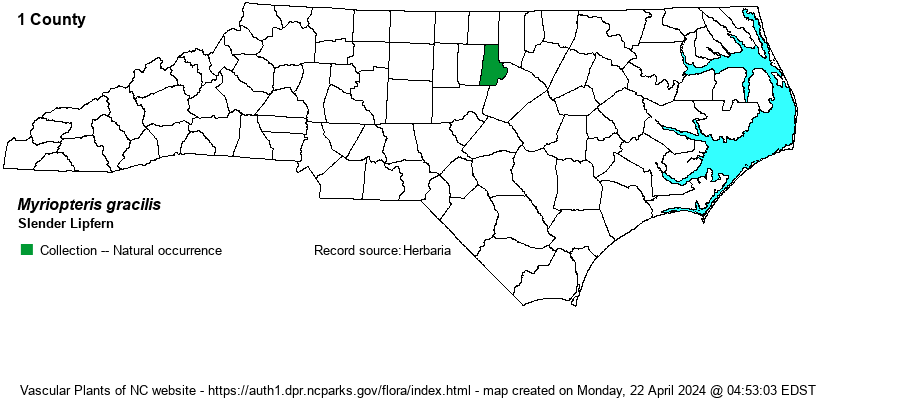| Author | Fee | |
| Distribution | Known only from a 1930 collection from Durham County, far east of the usual range; it had languished in an herbarium as "Cheilanthes lanosa" (now Myriopteris lanosa) until re-examined early in this century, as M. gracilis (formerly C. feei). See journal article by Rothfels, Sigel, & Windham (2012).
This is a Midwestern and Western species, ranging east to WI, IL, and AR; there are single county records for northern KY, western VA, and north-central NC. As the habitat -- exposed rocks along the Eno River --where collected in NC seems to be a natural one, Weakley (2018) considers it as native to NC. | |
| Abundance | There are no additional NC records. The NCNHP has assigned a State Rank of SH (Historical) and is now tracking the species as Significantly Rare. | |
| Habitat | Within the main portion of its range, it is a species of dry rock outcrops, typically where calcareous. The Eno River site certainly does not contain calcareous rocks (limestone), but the plant can grow (perhaps) on mafic rocks where the soil is of high pH. |
| Phenology | Fruits probably from about June to September. | |
| Identification | This is a rather tiny fern of rock crevices, with a wiry stipe about 4 inches long and a blade only about 4-5 inches long and barely 1 inch wide, rarely to 1.5 inches wide. The frond is tripinnate. The species differs from the much more numerous (in the East) M. lanosa by having its ultimate blade segments 1-3 mm long, round in shape (bead-like), and thus almost microscopic; M. lanosa is bipinnate-pinnatifid, such that the pinnules are not cut to the base, the ultimate blade segments 3-5 mm long, elongate and not bead-like (Weakley 2018). Though the species does have the sori in rows along the margins of the pinnules on the blade underside, which are down-curled over them, the plant is rather tiny and the sori would probably need to be studied with a hand lens. (Yes, the NC specimen is indeed tiny, and the pinnules do indeed look bead-like, barely looking leaf-like at all.) | |
| Taxonomic Comments | This and the other NC species formerly in Cheilanthes have now been moved to Myriopteris. This one also has had its scientific epithet changed, from feei to gracilis.
| |
| Other Common Name(s) | None | |
| State Rank | SH | |
| Global Rank | G5 | |
| State Status | SR-D | |
| US Status | | |
| USACE-agcp | | |
| USACE-emp | | |

